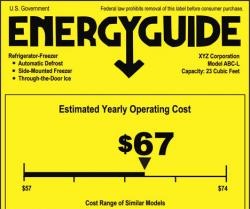Greedy TVs Put On Notice
Whether you're convinced by 3D or not, buying into the HDTV market has never been cheaper. Retailers are slashing sticker prices across the board – you can grab a 32-inch LCD online for well under $300 – but soon those stickers are going to become more complex as longer-term costs come into focus. Consumers may not realize it, but a huge chunk of what an HDTV costs them isn't just the initial purchase price, but the electricity that set sucks down.
In fact, almost a third of the cost of a TV over the average seven year life-cycle is down to energy running costs, according to IFA global director of consumer electronics Jürgen Boyny. On the average 42-inch LCD HDTV, with an €828 sticker price, power will add a further 31-percent – or €370 – during that seven year period. Perhaps more surprising is the range energy consumption spans across different sets from different manufacturers: some 32-inch HDTVs can use as little as 72W, while at the other end of the scale, some identically-sized HDTVs can consume over 150W.

In both the US and Europe, a new policy of mandatory energy efficiency labeling will look to address that confusion in 2011. TVs sold in the US after July 11 2011 will have to sport a bright yellow and black sticker – either square or triangular – indicating the estimated yearly operating cost. As for Europe, the EU Energy Label – already familiar on home appliances like washing machines and freezers – will be mandatory this year, rating sets on a G (worst) to A (best) scale initially and then, in 2014, shifting from F to A+, in 2017 from E an A++, and finally from D to A+++ in 2020.
It's expected that technological limitations will prevent anything further than A+++. On that European scale, usually you'll need an LED-backlit set with no small amount of consideration given to energy efficiency to get an A rating. Most sets are in categories B through to D. The European Commission reckons that the average family with a 50-inch and 32-inch LCD TV would save €50 each year if they opted for A rated rather than D rated models.
The introduction of power labeling is likely to add an extra layer of confusion to the HDTV buying process: 720p or 1080p, LED backlighting or something else, smart TV technology and even how many HDMI ports and other connections. Still, the good news is that manufacturers have already got wise to the new transparency, and the average energy use per set has actually decreased model-to-model from 158W in 2008 to 118W in 2010. Still, it's worth loading up the calculator on your smartphone when you're out among the Best Buy shelves, to see whether that budget special TV will end up a bad decision when you factor in running costs.






